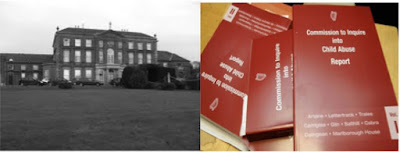‘They took the liberty of doing things, and the things they have done were an awful lot of evil things … I was only a young, innocent boy and I went through evil things that I didn’t want to go through. I went through their devilish hands … I was only dirt.’ (Ryan 5.85)
To answer Graham’s question is challenging, as it requires an examination of state policy towards intellectually disabled children in the 1950s. This examination is necessary as the 1950s were a pivotal period for the establishment of the Irish system of disability care, in which Catholic run institutions became a central component of the state’s overall policy. Indeed, the 1950s saw a huge expansion in the capacity of Catholic Church run institutions to care for disabled children, growing from 1,168 residential places across seven institutions in 1950 to 2,620 places across fourteen institutions in 1960.
One reason for the propagation of Catholic institutional care lay in one of the predominant forces shaping state policy in 1950s Ireland, that of subsidiarity. This idea, which originated in Pope Pius XI’s encyclical Quadragesimo Anno (1931), held that ‘the task of the state … was to facilitate activity by other groups and persons within the community but not to supersede these if they were working with reasonable efficacy.’ In the case of the intellectually disabled, subsidiarity meant encouraging the development of voluntary sector efforts to care for this group. The state should not involve itself directly in the care of the disabled, the encyclical describing such an idea as ‘a great evil and disturbance of right order.’ The spread of subsidiarity was aided by a more general shift in Irish governance methods from the late 1940s onwards, as the state became more committed to Catholic concepts of statehood. Thus, to create a system of publicly funded, but privately operated, institutions aligned with the dominant ethos of Irish public policy in the 1950s.
A second probable reason lies in bureaucratic inertia within the Department of Health. Minutes from a meeting in November 1953 discuss three possible avenues ‘for providing [further] accommodation for mental defectives.’ These options were: Catholic run institutions, Catholic managed institutions with lay staff or institutions operated by local councils. Yet, while there were three options, only Catholic run institutions were considered by the Department of Health. Indeed, even the initial November 1953 meeting to consider the three options focused solely on religious run institutions, the minutes bemoaned ‘the reluctance of male orders to undertake further schemes.’ At the same meeting, Dr. Dolphin (a senior civil servant within the Department) noted his plans to visit a number of religious orders, including the La Sagesse order in Liverpool, the Order of the Sisters of the Sacred Heart of Jesus and Mary and the Augustinian Nuns, all to ‘enquire into their capacity for undertaking the care of Mental Defectives and the possible location of an institution which they might set up.’ Thus, both the prevailing trend within the state and the orientation of influential civil servants favoured an expansion of Church run institutions to care for the intellectually disabled.
This helps to account for the growth of these institutions in the 1950s, but not the lack of oversight from the state. The Ryan Commission alone, for example, noted the almost total absence of oversight from the state into conditions within church run institutions. A key reason for this may lie in the venerated position of Catholic religious orders in Irish life. Within the Irish parliament (Dáil Éireann), the work of religious orders was almost incessantly portrayed as beyond reproach, with members of Parliament (Teachta Dála) describing how it was ‘a revelation to go into these institutions and see the spirit of devotion, self-sacrifice and loyalty’ displayed by orders like the Brothers of Charity in the care of the intellectually disabled. Such veneration of the role of religious orders may account for why Graham’s institution, Our Lady of Good Counsel in Glanmire, did not receive an official inspection from either the Department of Health or the Southern Health Board ‘between the period 1939 and 1990.’ (5.39)
Hence, to even begin to answer Graham’s question requires interrogating a diverse range of influences that shaped mid-twentieth century Ireland. These forces determined the acceptable form of care for children with intellectual disabilities, leaving the state as the funder for a network of privately run uninspected institutions. Combined with the norms that venerated the authority and probity of the clergy, the Irish state produced an toxically insular system of disability provision, in which the abuse described by Graham could truly flourish.
 |
Pictures of the home ‚Our Lady of Good Counsel“ and the Ryan Commission report
|
Works cited:
- Barrington, Ruth. Health, Medicine & Politics in Ireland, 1900-1970. Dublin: Institute of Public Administration, 1987.
- Power, Andrew et al. Active Citizenship & Disability: Implementing the Personalisation of Support. Cambridge: Cambridge University Press, 2013.
- Ryan, Seán et al. The Commission to Inquire into Child Child Abuse. Dublin, 2009.
- Whyte, John Henry. Church and State in Modern Ireland, 1923-1970. Dublin: Gill & Macmillan, 1971.
Recommended Citation
David Kilgannon (2016): ‘Whose idea was it?’ Institutionalisation, State Policy and the Intellectually Disabled in 1950s Ireland. In: Public Disability History 1 (2016) 15.
About the author:
David Kilgannon is a Wellcome Trust PhD researcher in the History Department of the National University of Ireland, Galway. He was previously a Hardimann Scholar and a Wellcome Trust MA student. His research looks at the varied experiences of persons with intellectual disabilities in Ireland from 1947 to 1996. His previous research looked at the experience of AIDS activists in Ireland from 1983-9.
Academia.edu: https://insight-centre.academia.edu/DavidKilgannon


